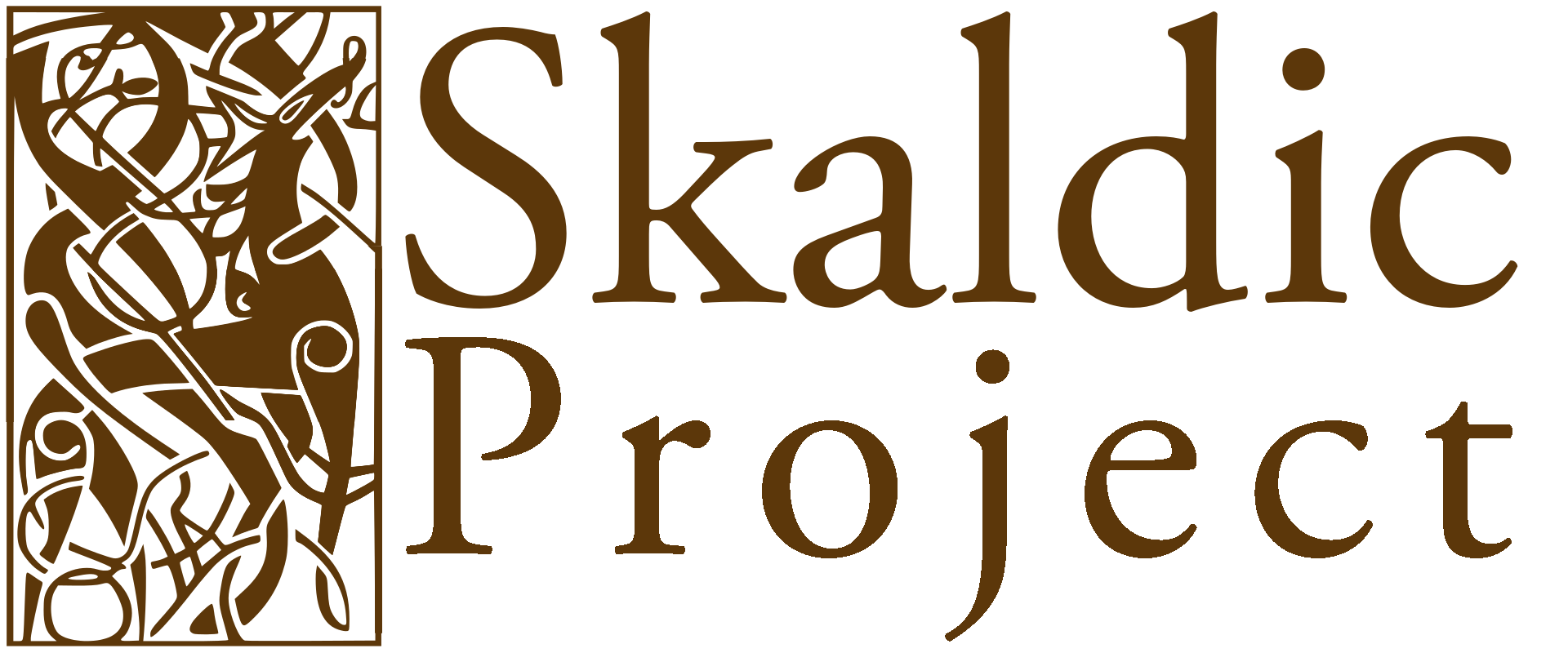Þhorn Gldr 4I
Edith Marold (ed.) 2012, ‘Þorbjǫrn hornklofi, Glymdrápa 4’ in Diana Whaley (ed.), Poetry from the Kings’ Sagas 1: From Mythical Times to c. 1035. Skaldic Poetry of the Scandinavian Middle Ages 1. Turnhout: Brepols, p. 83.
Ok allsnœfrir jǫfrar
orðalaust at morði
— endisk rauðra randa
rǫdd — dynskotum kvǫddusk.
Ok allsnœfrir jǫfrar kvǫddusk orðalaust dynskotum at morði; {rǫdd rauðra randa} endisk.
And the very vigorous rulers greeted each other wordlessly with din-shots at the battle; {the voice of the red shields} [BATTLE] sufficed.
Mss: Kˣ(55r), F(9va), J1ˣ(30r), J2ˣ(31v) (Hkr); FskBˣ(6r), FskAˣ(18) (Fsk); Flat(76vb) (Flat); 761aˣ(20v/8), 761aˣ(20v/20) (l. 1)
Readings: [1] allsnœfrir: so F, J1ˣ, J2ˣ, 761aˣ(20v/8), ‘allz næfrir’ Kˣ, ‘orð nófrir’ FskBˣ, ósnæfrir FskAˣ, ‘ofnæfrir’ Flat [4] rǫdd: so all others, rǫð Kˣ; kvǫddusk: so F, J1ˣ, J2ˣ, FskBˣ, FskAˣ, Flat, 761aˣ(20v/8), ‘kvꜹddr’ Kˣ
Editions: Skj AI, 22-3, Skj BI, 20, Skald I, 13, NN §1020; Hkr 1893-1901, I, 110, IV, 30-1, ÍF 26, 103, Hkr 1991, I, 63 (HHárf ch. 10), F 1871, 42 ; Fsk 1902-3, 18 (ch. 2), ÍF 29, 69 (ch. 3); Fms 10, 187-8, Fms 12, 225, Flat 1860-8, I, 572 (HarHárf).
Context: See st. 3.
Notes: [All]: On the arrangement of sts 3-4, for which this edn follows the Fsk mss, see Note to st. 3 [All]. — [2, 4] kvǫddusk orðalaust dynskotum ‘greeted each other wordlessly with din-shots’: The opponents’ shooting at one another is metaphorically compared to a greeting (kvǫddusk). This metaphorical use is made more explicit by the blend of the figurative (kvǫddusk ‘greeted each other’) and the concrete (dynskotum ‘with din-shots’). Orðalaust ‘wordlessly’, a n. adj. used adverbially, focuses additional attention on the metaphorical use of kvǫddusk by directly contradicting it. The metaphor is then reiterated by the kenning rǫdd rauðra randa ‘the voice of the red shields [BATTLE]’ (cf. Fidjestøl 1982, 219). — [3] endisk ‘sufficed’: For the meaning ‘suffice’ see LP: enda 2; Fritzner: enda 5. The sense seems to be that the only communication necessary was the fighting and the sound it made.
References
- Bibliography
- Fms = Sveinbjörn Egilsson et al., eds. 1825-37. Fornmanna sögur eptir gömlum handritum útgefnar að tilhlutun hins norræna fornfræða fèlags. 12 vols. Copenhagen: Popp.
- Skald = Kock, Ernst Albin, ed. 1946-50. Den norsk-isländska skaldediktningen. 2 vols. Lund: Gleerup.
- NN = Kock, Ernst Albin. 1923-44. Notationes Norrœnæ: Anteckningar till Edda och skaldediktning. Lunds Universitets årsskrift new ser. 1. 28 vols. Lund: Gleerup.
- LP = Finnur Jónsson, ed. 1931. Lexicon poeticum antiquæ linguæ septentrionalis: Ordbog over det norsk-islandske skjaldesprog oprindelig forfattet af Sveinbjörn Egilsson. 2nd edn. Copenhagen: Møller.
- Fidjestøl, Bjarne. 1982. Det norrøne fyrstediktet. Universitet i Bergen Nordisk institutts skriftserie 11. Øvre Ervik: Alvheim & Eide.
- Flat 1860-8 = Gudbrand Vigfusson [Guðbrandur Vigfússon] and C. R. Unger, eds. 1860-8. Flateyjarbók. En samling af norske konge-sagaer med indskudte mindre fortællinger om begivenheder i og udenfor Norge samt annaler. 3 vols. Christiania (Oslo): Malling.
- Fritzner = Fritzner, Johan. 1883-96. Ordbog over det gamle norske sprog. 3 vols. Kristiania (Oslo): Den norske forlagsforening. 4th edn. Rpt. 1973. Oslo etc.: Universitetsforlaget.
- ÍF 26-8 = Heimskringla. Ed. Bjarni Aðalbjarnarson. 1941-51.
- Hkr 1893-1901 = Finnur Jónsson, ed. 1893-1901. Heimskringla: Nóregs konunga sǫgur af Snorri Sturluson. 4 vols. SUGNL 23. Copenhagen: Møller.
- Hkr 1991 = Bergljót S. Kristjánsdóttir et al., eds. 1991. Heimskringla. 3 vols. Reykjavík: Mál og menning.
- F 1871 = Unger, C. R., ed. 1871. Fríssbók: Codex Frisianus. En samling af norske konge-sagaer. Christiania (Oslo): Malling.
- Fsk 1902-3 = Finnur Jónsson, ed. 1902-3. Fagrskinna: Nóregs kononga tal. SUGNL 30. Copenhagen: Møller.
- ÍF 29 = Ágrip af Nóregskonunga sǫgum; Fagrskinna—Nóregs konungatal. Ed. Bjarni Einarsson. 1985.
- Internal references
- (forthcoming), ‘ Unattributed, Fagrskinna’ in Kari Ellen Gade (ed.), Poetry from the Kings’ Sagas 2: From c. 1035 to c. 1300. Skaldic Poetry of the Scandinavian Middle Ages 2. Turnhout: Brepols, p. . <https://skaldic.org/m.php?p=text&i=56> (accessed 25 April 2024)
- (forthcoming), ‘ Unattributed, Haralds þáttr hárfagra’ in Kari Ellen Gade (ed.), Poetry from the Kings’ Sagas 2: From c. 1035 to c. 1300. Skaldic Poetry of the Scandinavian Middle Ages 2. Turnhout: Brepols, p. . <https://skaldic.org/m.php?p=text&i=137> (accessed 25 April 2024)
- (forthcoming), ‘ Heimskringla, Haralds saga hárfagra’ in Kari Ellen Gade (ed.), Poetry from the Kings’ Sagas 2: From c. 1035 to c. 1300. Skaldic Poetry of the Scandinavian Middle Ages 2. Turnhout: Brepols, p. . <https://skaldic.org/m.php?p=text&i=140> (accessed 25 April 2024)
Stanza/chapter/text segment
Use the buttons at the top of the page to navigate between stanzas in a poem.
Information tab
- text: if the stanza has been published, the edited text of the stanza and translation are here; if it hasn't been published an old edition (usually Skj) is given for reference
- sources: a list of the manuscripts or inscriptions containing this stanza, with page and line references and links (eye button) to images where available, and transcription where available
- readings: a list of variant manuscript readings of words in the main text
- editions and texts: a list of editions of the stanza with links to the bibliography; and a list of prose works in which the stanza occurs, allowing you to navigate within the prose context
- notes and context: notes not linked to individual words are given here, along with the account of the prose context for the stanza, where relevant
Interactive tab
The text and translation are given here, with buttons to toggle whether the text is shown in the verse order or prose word order. Clicking on indiviudal words gives dictionary links, variant readings, kennings and notes, where relevant.
Full text tab
This is the text of the edition in a similar format to how the edition appears in the printed volumes.
Chapter/text segment
This view is also used for chapters and other text segments. Not all the headings shown are relevant to such sections.
